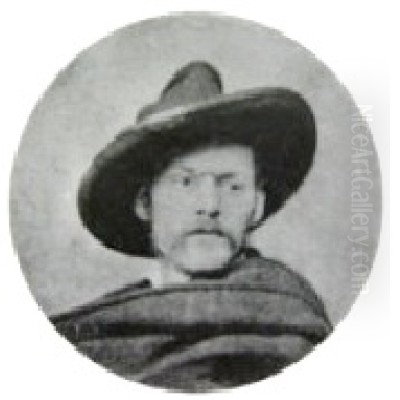
Frank Myers Boggs stands as a fascinating figure in the transatlantic art world of the late nineteenth and early twentieth centuries. An American by birth but largely Parisian by choice and artistic sensibility, Boggs navigated the currents of traditional academic training and the revolutionary tides of Impressionism, forging a distinct path characterized by atmospheric sensitivity and a deep affection for maritime and urban landscapes. His life and work offer a compelling study of an artist who achieved significant recognition in his adopted homeland of France, while his American roots provided a unique perspective that subtly informed his celebrated canvases.
Early Life and Artistic Beginnings
Frank Myers Boggs was born on December 6, 1855, in Springfield, Ohio. His formative years, however, were spent in New York City, where his family relocated during his youth. This move placed the young Boggs in a burgeoning cultural center, an environment likely to have nurtured his nascent artistic inclinations. His father's profession as a newspaper editor, and reportedly a wood engraver associated with prominent publications like Harper's Weekly, provided a direct connection to the world of visual arts and print media.
This familial connection seems to have paved the way for Boggs's initial foray into the professional art world. By the age of seventeen, he was employed as a wood engraver, honing his skills in precision and line work for the New York Herald. This early training in a graphic medium, demanding close observation and technical control, likely provided a solid foundation for his later work in painting and etching, even as his stylistic preferences evolved. While engraving offered a practical entry point, Boggs's ambitions soon turned towards the more expressive possibilities of painting. Some accounts suggest early, informal studies in New York, possibly with landscape painters, before he made the pivotal decision to pursue formal training abroad.
Parisian Training and Influences
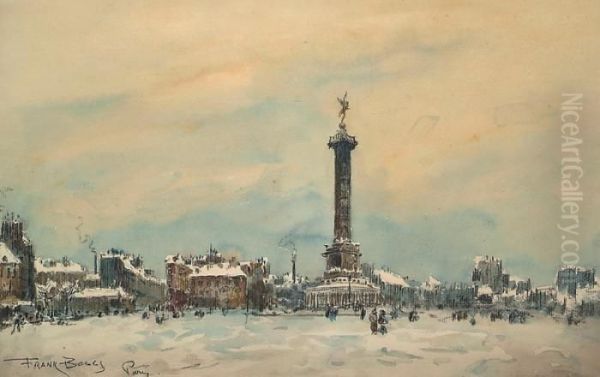
In 1876, at the age of twenty, Frank Boggs embarked on the journey that would define much of his artistic life, traveling to Paris. This was a common path for ambitious American artists of his generation, seeking the rigorous instruction and vibrant artistic milieu that the French capital offered. Boggs enrolled in the prestigious École des Beaux-Arts, the bastion of academic tradition in France. There, he entered the atelier of Jean-Léon Gérôme, one of the most famous and respected academic painters of the era.
Gérôme was known for his meticulously detailed historical scenes and Orientalist subjects, executed with a polished finish and precise draughtsmanship. Studying under Gérôme provided Boggs with a thorough grounding in academic principles – anatomy, perspective, composition, and a high degree of finish. However, the Paris Boggs entered was also the epicenter of the Impressionist revolution. While Gérôme represented the established order, artists like Claude Monet, Camille Pissarro, Alfred Sisley, and Pierre-Auguste Renoir were challenging academic conventions with their focus on capturing fleeting moments, the effects of light and atmosphere, and contemporary life, often painted en plein air (outdoors).
Boggs absorbed the lessons of his academic training but was undeniably drawn to the innovations happening outside the École's walls. He became acquainted with the work, and likely some of the artists, associated with Impressionism. He developed a particular affinity for marine painters and those who excelled at capturing atmospheric effects, such as Eugène Boudin, whose luminous depictions of Normandy skies and shores were a direct inspiration for Monet. Boggs found himself navigating between the structured world of Gérôme's studio and the looser, light-filled canvases of the Impressionists.
Development of a Unique Style
Frank Myers Boggs did not become a doctrinaire Impressionist in the mold of Monet or Renoir. While clearly influenced by their attention to light, atmosphere, and modern subjects, his artistic temperament led him down a slightly different path. He synthesized elements of his academic training, particularly a sense of structure and solidity, with the atmospheric concerns of Impressionism and the moody sensitivity of Tonalism, an American movement gaining traction concurrently.
Unlike many Impressionists who chased the brilliance of midday sun, Boggs often favored more subdued conditions: the soft, diffused light of early morning, the misty haze over a river, or the damp, reflective surfaces after a rain shower. His palette reflected this preference, often dominated by subtle harmonies of blues, greys, greens, and ochres. This tonal subtlety, combined with an emphasis on mood and atmosphere, sometimes drew comparisons to the work of James McNeill Whistler, another American expatriate artist who masterfully employed tonal harmonies.
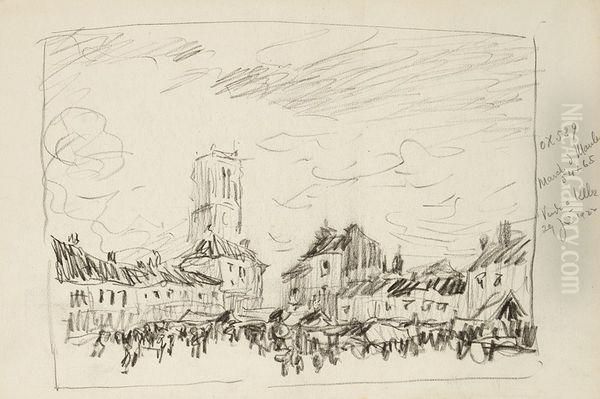
Boggs's brushwork, while becoming freer over time than the tight rendering favored by Gérôme, often retained a descriptive quality, defining forms more clearly than the broken color patches typical of high Impressionism. He excelled in watercolor, a medium well-suited to capturing transient effects of light and moisture, but he was also a highly accomplished oil painter and etcher. Across these media, his signature style emerged: a blend of observed reality, atmospheric envelopment, and a certain poetic melancholy, particularly evident in his depictions of water and sky.
Subject Matter: Capturing Place and Atmosphere
Boggs's primary subjects were landscapes, cityscapes, and marine views, drawn from the places he lived and traveled. Having settled in France, Parisian scenes became a recurring theme. He painted the Seine River extensively, capturing its bridges, barges, and the surrounding architecture under various light conditions. Works like The Seine, View of Pont d'Austerlitz exemplify his ability to render the bustling life of the river while simultaneously evoking a specific mood through his handling of light and atmosphere. The Place de la Bastille and views of Notre Dame also featured in his Parisian repertoire.
Beyond the capital, Boggs was drawn to the harbors and coastal towns of France, particularly in Normandy, a region beloved by Boudin, Monet, and others. Honfleur, Dieppe, and Trouville offered rich subject matter with their fishing boats, bustling quays, and changeable weather. His marine paintings often focus on the interplay of water, sky, and vessels, showcasing his skill in rendering reflections and the subtle shifts in color caused by atmospheric conditions.
His travels also took him to the Netherlands, where he painted the distinctive canals, architecture, and harbors of cities like Amsterdam and Dordrecht. His Amsterdam Cathedral (likely referring to a prominent church) and views of Dordrecht's busy port reveal his appreciation for the maritime heritage and unique atmospheric light of Holland, perhaps echoing the tradition of Dutch Golden Age marine painters like Jacob van Ruisdael or Willem van de Velde the Younger, as well as later Hague School artists like Jacob Maris. Venice, with its unique combination of water and architecture, also provided inspiration. Although he spent most of his adult life abroad, American scenes occasionally appeared, notably the early work Clamming at Shelter Island, painted before his extended expatriation.
An American Expatriate in France
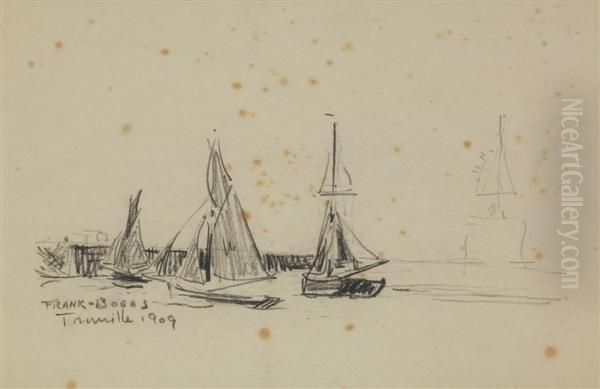
Frank Myers Boggs spent the majority of his productive artistic life in France. While many American artists studied in Paris and returned home, Boggs became deeply integrated into the French art world. He exhibited regularly at the prestigious Paris Salon, the official exhibition venue, beginning in 1880. His work quickly gained favor with French critics and collectors, who appreciated his blend of solid draughtsmanship and atmospheric sensitivity.
His success in France was notable. The French government acquired two of his paintings for the state collection, initially housed in the Musée du Luxembourg, which was dedicated to living artists, a significant honor indicating official recognition. This level of acceptance by the French establishment was a testament to his skill and his ability to resonate with French aesthetic sensibilities. He moved in artistic circles that included prominent French painters, fostering connections that sustained his career abroad.
In 1923, Boggs formalized his deep connection to his adopted country by becoming a French citizen. This decision underscored his commitment to France, where his art had found its most receptive audience. His experience mirrors that of other successful American expatriate artists like John Singer Sargent, Mary Cassatt, and James McNeill Whistler, who found greater artistic freedom and recognition in Europe, though Boggs perhaps integrated even more fully into French life than some of his contemporaries. He maintained connections with the American art scene, exhibiting occasionally in the United States, but France remained his primary base and source of inspiration.
Recognition and Reception
Boggs achieved considerable success during his lifetime, particularly in France. His regular participation in the Paris Salon brought his work consistent visibility. Beyond the honor of state purchases, he received accolades at major international exhibitions. He was awarded a prize of $2,500 from the American Art Association in New York in 1885 (a substantial sum at the time), indicating recognition back home. Perhaps more significantly, he won a silver medal at the Exposition Universelle (World's Fair) in Paris in 1889, a major international event showcasing arts and industry.
His reputation in France continued to grow, culminating in a nomination for the prestigious Légion d'honneur (Legion of Honor), France's highest order of merit. Tragically, Boggs passed away in 1926 before the honor could be formally bestowed, but the nomination itself speaks volumes about the esteem in which he was held.
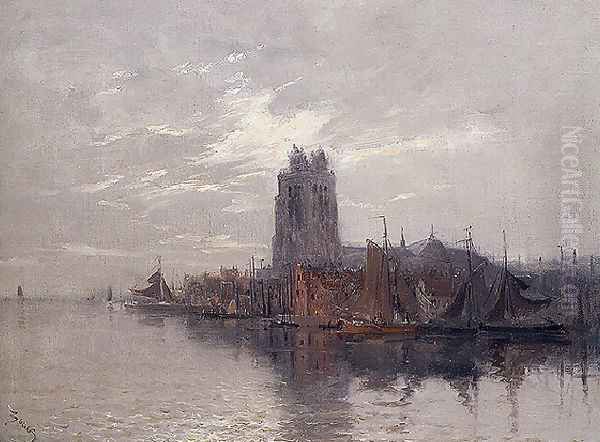
Despite this success abroad, his recognition in the United States was perhaps less pronounced during his lifetime compared to his standing in France. While his works entered important American museum collections, including the Metropolitan Museum of Art in New York, the Museum of Fine Arts, Boston, and the Pennsylvania Academy of the Fine Arts, his name did not achieve the same level of household familiarity as some American Impressionists like Childe Hassam or landscape painters like Winslow Homer. In later years, art historians and collectors have increasingly recognized the quality and unique position of his work, though some critics still feel his market value has not always reflected his artistic merit compared to some of his French Impressionist contemporaries.
Key Works Explored
Several paintings stand out as representative of Frank Myers Boggs's artistic achievements. The Seine, View of Pont d'Austerlitz (c. 1926), likely one of his later works, encapsulates his mature style. It depicts the bustling river traffic near the Austerlitz Bridge in Paris, rendered with fluid brushwork and a masterful control of atmospheric perspective. The grey light, the reflections on the water, and the sense of urban energy combined with a slightly melancholic mood are characteristic of his Parisian scenes.
Clamming at Shelter Island (1878) offers a glimpse into his earlier, American period. Painted before he fully immersed himself in the French art scene, it shows his early interest in coastal subjects and natural light, perhaps with a tighter handling influenced more by American realism than French Impressionism. It demonstrates his connection to the American landscape tradition, associated with artists like Winslow Homer, though Boggs's path would soon diverge significantly.
His depictions of French ports, such as Honfleur or Trouville, showcase his affinity for maritime subjects. These works often feature carefully composed arrangements of boats, docks, and buildings under expansive, expressive skies. Boggs excelled at capturing the specific light and weather of the Normandy coast, echoing the work of Boudin and Jongkind, another important precursor to Impressionism known for his marine views.
Views of Dutch harbors, like those of Dordrecht, are notable for their robust composition and dramatic rendering of light and water. These works often possess a strong sense of place, capturing the unique character of Dutch maritime life with an approach that blends realistic detail with impressionistic handling of atmosphere. Similarly, Amsterdam Cathedral (likely a major church) would have allowed him to explore the interplay of imposing architecture and the watery, reflective environment of the Dutch city.
Across these works, a consistent sensitivity to light, atmosphere, and the character of place emerges. Whether depicting the urban landscape of Paris, the coastal life of Normandy, or the canals of Holland, Boggs brought a unique perspective, informed by both his American background and his deep engagement with French art.
Boggs and His Contemporaries
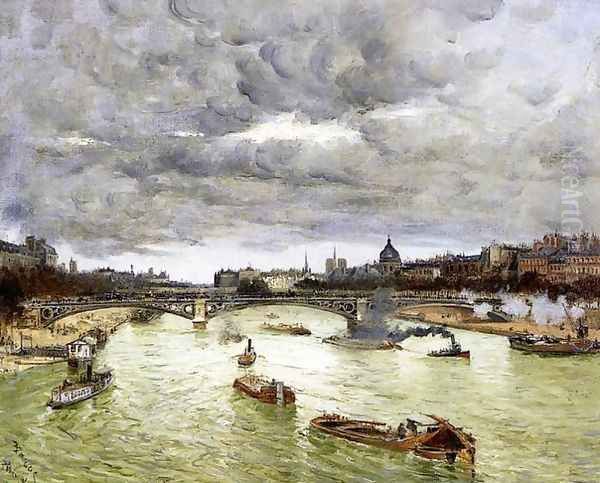
Frank Myers Boggs occupied an interesting position relative to his contemporaries. His teacher, Jean-Léon Gérôme, represented the pinnacle of the academic tradition that Impressionism sought to overthrow. Boggs clearly absorbed Gérôme's lessons in structure and drawing, which provided a foundation distinct from some self-taught or more radically experimental artists. Yet, he embraced the modern subjects and atmospheric concerns championed by the Impressionists.
He was a contemporary of the major French Impressionists – Monet, Renoir, Sisley, Pissarro – and shared their interest in landscape, cityscape, and the effects of light. He also knew and admired Eugène Boudin, whose influence is palpable in Boggs's handling of skies and water. However, Boggs maintained a degree of independence, never fully adopting the high-keyed palette or broken brushwork characteristic of Monet's later work.
His style finds parallels with American Tonalism, particularly in its emphasis on mood and subtle color harmonies, linking him to artists like James McNeill Whistler and George Inness. Like Whistler and John Singer Sargent, Boggs was an American expatriate who found significant success in Europe. However, unlike Sargent's dazzling society portraits or Whistler's highly aestheticized nocturnes, Boggs remained primarily focused on landscape and cityscape, rendered with a specific blend of realism and atmospheric poetry.
Compared to American Impressionists who worked primarily in the United States, such as Childe Hassam or Theodore Robinson (who was also influenced by Monet), Boggs's long residence in France gave his work a distinctly European flavor. His deep familiarity with French and Dutch locations, combined with his absorption of European artistic trends, set his work apart. He can be seen as a bridge figure, connecting American artistic sensibilities with the mainstream and avant-garde developments in late 19th-century France.
Later Life and Legacy
Frank Myers Boggs continued to paint actively throughout his life, traveling and finding inspiration in various European locales. He spent his final years in Meudon, a suburb southwest of Paris, where he died on August 8, 1926, shortly after being nominated for the Legion of Honor. His artistic legacy was continued, in a sense, by his son, Frank William Boggs (who often signed his work Frank Will), also an artist who worked in a style influenced by his father.
Today, Frank Myers Boggs is recognized as a significant American expatriate painter whose work offers a nuanced alternative to mainstream Impressionism. His paintings are valued for their technical skill, their evocative rendering of atmosphere, and their sensitive depiction of place. His ability to capture the specific mood of harbors, rivers, and cities under varying conditions of light and weather remains compelling.
His works are held in numerous important public collections on both sides of the Atlantic, including the Metropolitan Museum of Art, the Brooklyn Museum, the Smithsonian American Art Museum, the Museum of Fine Arts, Boston, the Art Institute of Chicago, the Pennsylvania Academy of the Fine Arts, the Musée d'Orsay (inheriting works from the Luxembourg and Louvre), and various regional French museums. This institutional presence ensures the continued visibility and study of his art. While perhaps not as widely celebrated as some of his Impressionist peers, Boggs holds a secure place as a distinctive voice in the rich artistic dialogue between America and Europe at the turn of the twentieth century.
Conclusion
Frank Myers Boggs carved a unique niche for himself in the art history of the late nineteenth and early twentieth centuries. An American who found his artistic home in France, he skillfully blended academic training with the atmospheric innovations of Impressionism and Tonalism. His preference for misty harbors, rain-slicked Parisian streets, and the soft light of dawn or dusk resulted in a body of work characterized by subtle beauty, technical assurance, and a profound sense of place. Highly esteemed in France yet rooted in his American origins, Boggs remains an important figure whose evocative landscapes and cityscapes continue to resonate with viewers, capturing moments of quiet poetry between two worlds.